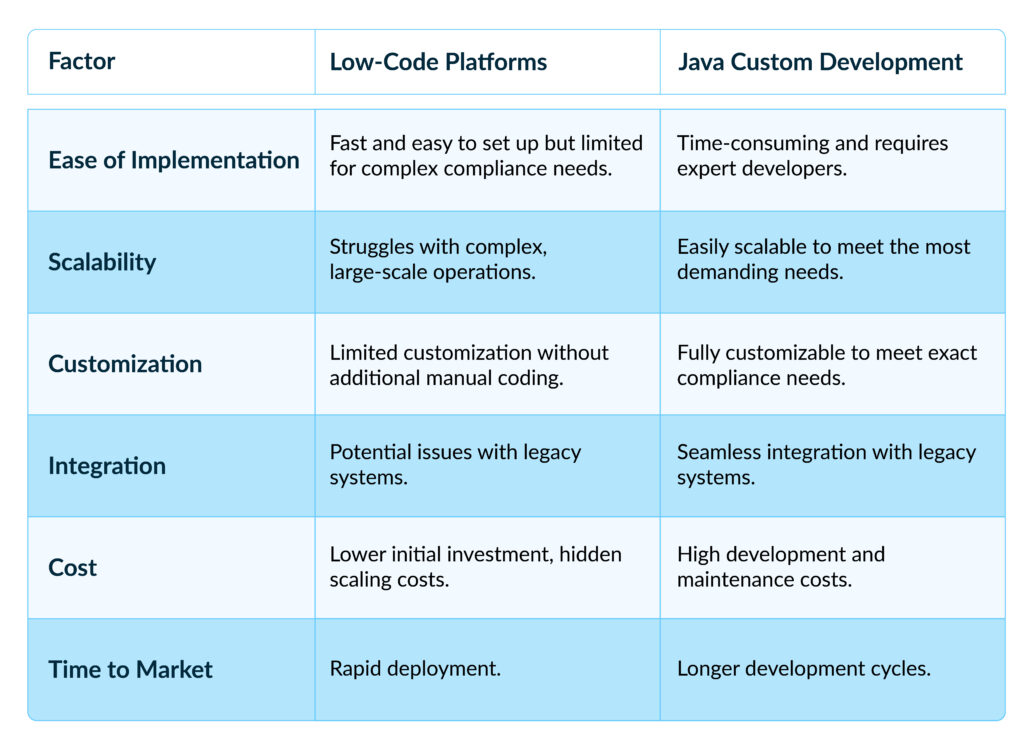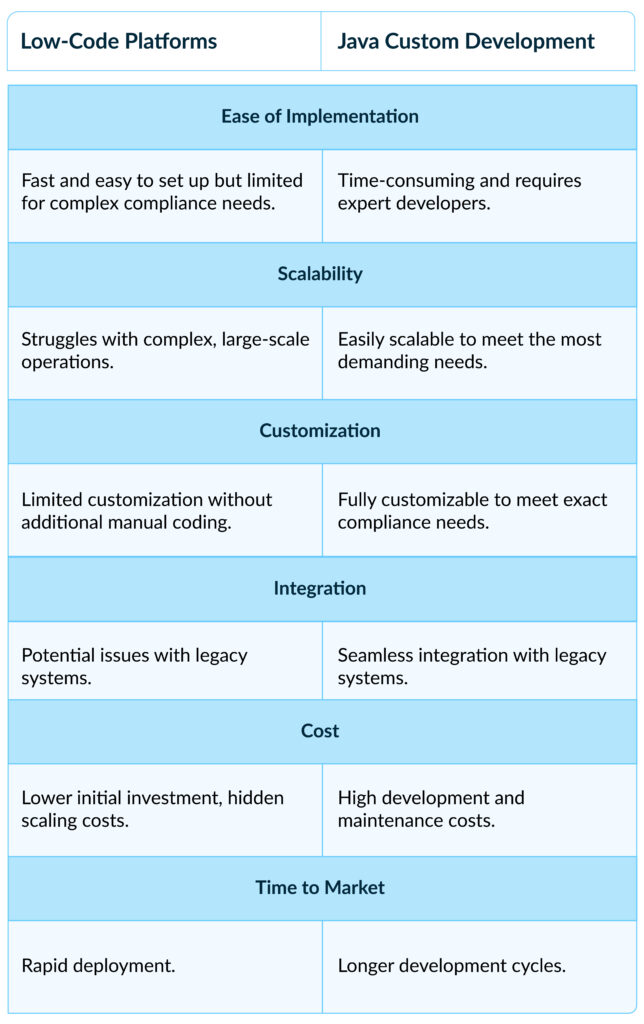Low-Code Platforms: Simplicity Meets Speed
Low-code platforms have gained popularity due to their ability to simplify application development, especially for businesses that need to respond quickly to changing regulations.
Key Strengths:
- Ease of Implementation: Low-code platforms allow for the rapid development of applications with minimal coding knowledge. This is particularly useful for compliance teams that need to quickly adjust to new regulations or business owners who don’t have enough knowledge of programming.
- Fast Time-to-Market: These platforms are designed to speed up the application development process, which is critical for companies in fast-paced regulatory environments.
- Cost-Effective: Low-code platforms tend to have a lower initial investment compared to custom development, making them attractive for businesses looking to manage compliance on a budget.

Key Weaknesses:
- Scalability: As compliance needs grow and become more complex, low-code platforms can struggle to keep up. This can lead to performance issues or limitations when trying to manage large-scale compliance operations.
- Customization: While low-code platforms offer some degree of customization, they often fall short when faced with highly specific compliance requirements. Complex workflows or multi-step compliance processes may require manual coding or additional solutions.
- Integration Issues: Low-code platforms can struggle with integrating into existing systems, especially legacy systems, which are common in heavily regulated industries.
Java Custom Development: The Flexibility Powerhouse
Java has long been a go-to option for organizations looking for full control over their applications, including compliance management systems.
Key Strengths:
- Complete Customization: With Java, organizations can build applications that meet their exact compliance needs. There are no limitations imposed by platform constraints, and companies can design solutions from the ground up to fit their regulatory requirements.
- Scalability: Java applications are highly scalable and can handle vast amounts of compliance data, making them suitable for large organizations with complex regulatory demands.
- Robust integration: Java-based solutions can seamlessly integrate with existing systems, including legacy systems, making them ideal for industries that rely on a combination of old and new technologies.

Key Weaknesses:
- High Cost: Custom development with Java is resource-intensive. The development process takes longer, and maintenance can be costly, especially when updates are needed to keep up with regulatory changes.
- Less Flexible: If you have a process that gets altered often or involves constantly changing regulations, using Java can get problematic when you need to make changes to the application. You would need to dig into the code, find the parts that are relevant, and then update it. This could take a lot of time and effort.
- Slow Time-to-Market: Developing a fully custom compliance solution in Java can take months or even years, leaving organizations vulnerable to regulatory non-compliance in the meantime.
- Skill Requirements: Java development requires highly skilled developers, which can be a challenge for organizations without a dedicated technical team.


What Should You Choose?
When comparing low-code platforms and Java for compliance management, organizations often face a trade-off between speed and customization. Low-code platforms provide quick deployment and ease of use, while Java offers full customization but requires more time and resources. However, what if your needs don’t fully align with either of these options?
This is where platforms like ours come in. Rather than fitting strictly into the low-code or Java categories, Be Informed’s RegTech platform combines elements of both approaches. It offers the speed and flexibility of low-code while providing the seamless integration and customization often associated with Java-based solutions. Apart from that, it provides complete traceability to the origins of regulations which is necessary when working in everchanging regulatory environments. This makes it an interesting option for organizations that need both rapid deployment and the ability to handle complex regulatory landscapes.
Be Informed’s approach focused on the knowledge models allows organizations to adapt to changing regulations quickly, without the lengthy development times of custom Java solutions. Yet, it doesn’t sacrifice the ability to manage intricate workflows or automate complex decision-making processes.
Ultimately, the right choice depends on your organization’s needs, whether that’s the rapid adaptability of low-code, the full customization of Java, or a solution that stands in the middle. The evolution of compliance management will likely see a rise in platforms that integrate the best of both worlds, offering organizations more balanced options to navigate an increasingly complex regulatory environment.









